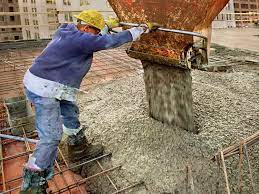Concrete is a versatile and long-lasting building material that is commonly used for foundations, driveways, patios, and other applications. However, the climate in which concrete is installed can have a significant impact on its performance. Extreme weather, whether freezing cold or scorching hot, can present unique challenges for concrete slabs. In this blog, we will look at the considerations and tips for successfully using concrete slabs in both cold and hot climates.
Cold-Weather Issues and Solutions
1. Freezing Temperatures: Freezing temperatures in cold climates can cause concrete to crack and weaken. When the water in the concrete mix freezes, it expands and applies pressure to the surrounding concrete. To address this matter:
- Use Air-Entrained Concrete: Air-entrained concrete contains tiny air bubbles that allow it to expand and contract without cracking. It is a good option for cold-weather applications.
- Curing: Make sure the concrete is properly cured to avoid premature drying and to promote strength development. To retain heat, blankets, straw, or insulating materials may be used to cover the concrete.
2. Deicing Agents: Deicing salts are commonly used on roads and sidewalks in snowy areas. These chemicals can cause long-term damage to concrete surfaces by increasing the risk of scaling and spalling. To protect your concrete slabs, take the following precautions:
- Seal the Surface: Apply a high-quality concrete sealer to the surface to create a barrier that prevents water and deicing salts from penetrating the concrete.
- Regular Maintenance: Remove snow and ice as soon as possible to reduce the need for deicing chemicals. For traction, use non-corrosive materials such as sand or cat litter.
3. Proper Joint Placement: In cold climates, expansion and control joints are required to allow for concrete movement and prevent cracking. Check that these joints are properly spaced and designed to withstand temperature fluctuations.
High-Temperature Difficulties and Solutions
1. Rapid Moisture Loss: In hot and arid areas, rapid moisture evaporation during the curing process can cause surface cracks, reduced strength, and decreased durability. To address this issue:
- Keep the Surface Moist: During the critical curing period, use curing methods such as wet burlap, wet curing blankets, or curing compounds to keep the concrete surface consistently moist.
- Protection from The Sun And Wind: Protect the concrete from direct sunlight and strong winds, both of which can hasten moisture evaporation.
2. Increased Risk of Thermal Cracking: Concrete can crack due to thermal expansion caused by high temperatures. To address this issue:
- Temperature Control: Pour concrete during cooler times of day, such as early morning or late evening, to lower the initial concrete temperature.
- Use Shading and Insulation: To reduce temperature differentials, protect freshly poured concrete with shading or insulation.
3. Adequate Mix Design: Select concrete mixes that are suitable for high-temperature environments. To improve workability and reduce the risk of thermal cracking, these mixes frequently include additives such as fly ash, slag, or special admixtures.
General Suggestions for Both Climates
1. Adequate Reinforcement: Reinforcing your concrete slab with steel or fiber reinforcement can provide additional strength and crack resistance in extreme climates.
2. Select the Correct Finish: Carefully consider the finish of your concrete slab. Some finishes, such as exposed aggregate or brushed concrete, may be better suited to high-traffic areas and harsh weather.
3. Concrete Mix Quality: Ensure that the concrete mix used meets the necessary standards and specifications for your specific climate. To get the right mix design, consult with a reputable concrete supplier.
4. Appropriate Sloping and Drainage: Create appropriate slopes and drainage channels in your concrete slabs to prevent water from pooling on the surface, which can lead to freezing in cold weather and erosion in hot weather.
5. Ongoing Maintenance: Regardless of the climate, regular maintenance is essential. Inspect your concrete slabs on a regular basis for signs of damage or wear, and address any issues as soon as possible to avoid further damage.
6. Consult with Experts: It is best to consult with experienced concrete contractors like modernconcretecontractors.com or engineers who are familiar with local weather conditions when planning a concrete project in extreme climates. They can offer useful insights and recommendations tailored to your specific situation.
The Hoover Dam Bypass Bridge as a Case Study
The Hoover Dam Bypass Bridge, also known as the Mike O’Callaghan-Pat Tillman Memorial Bridge, spans the Colorado River in the desert southwest of the United States and is one of the most iconic examples of concrete construction in extreme weather conditions.
Challenge: The project faced both hot and arid desert conditions, with temperatures in the summer months exceeding 100°F (37°C).
Solution: Several measures were taken to combat the extreme heat and prevent thermal cracking:
- Cooling Pipes: The concrete used in the project included cooling pipes that circulated chilled water to keep the concrete temperature low.
- Moisture and Shading: Shading was used to protect the concrete surface from direct sunlight, and curing methods were used to ensure that the concrete retained moisture during the curing process.
Conclusion
With the proper design, materials, and maintenance, concrete slabs can thrive in harsh climates. Whether you’re working in freezing temperatures or scorching heat, it’s critical to carefully plan and execute your concrete projects. Consider local weather patterns, consult with experts, and adhere to best practices to ensure the durability and resilience of your concrete slabs in any climate. By addressing climate-specific issues, you can reap the benefits of concrete for many years to come, click here to learn more.

